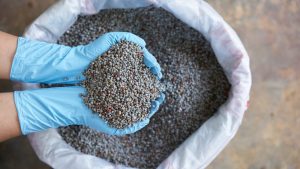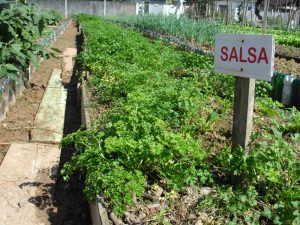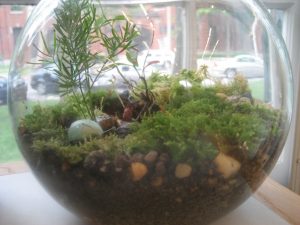Last Updated on March 19, 2024 by teamobn
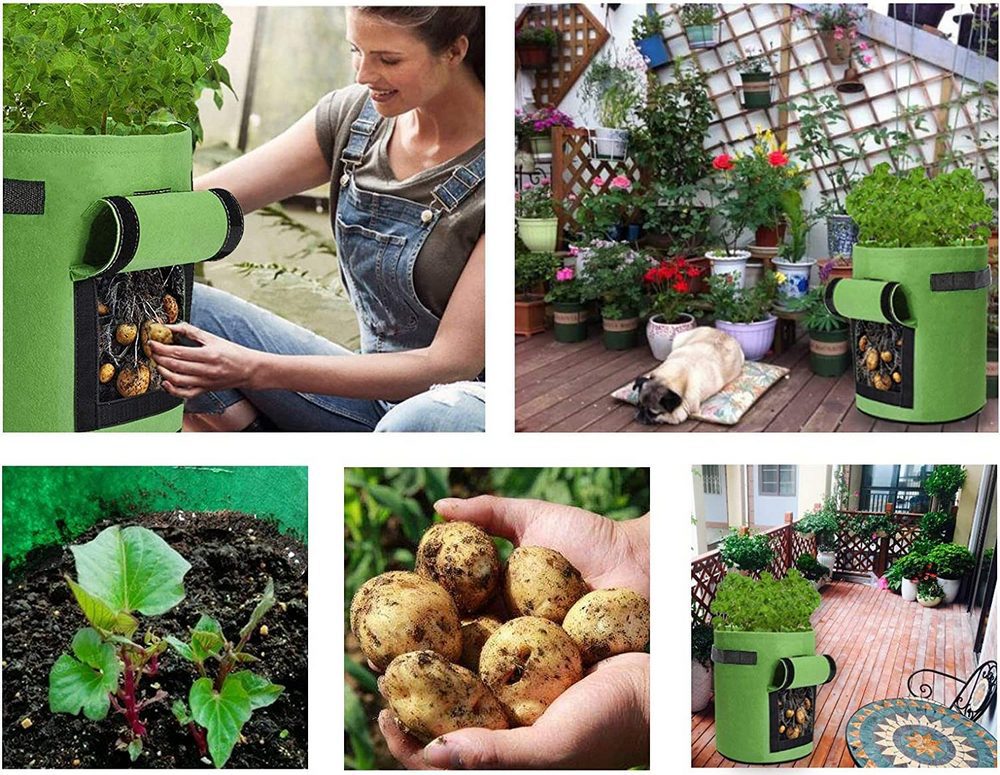
Potato grow bags are a godsend for gardening enthusiasts who love spuds but have limited space in which to grow them. They also make harvesting easy. All you have to do is empty the contents of the bag, collect up the tubers, and dispose of the compost on other beds or borders to improve the soil.
The joy of hunting for taters in a bag full of compost is a childishly delightful task. We here at OBN are always excited by the prospect of tipping over a potato grow bag to find edible gold.
Potatoes are packed with nutrition. A typical potato contains over half the day’s requirement of vitamins B6 and C and almost half of the potassium. They’re also a good source of fiber, niacin, thiamin, folate, magnesium, and manganese, among others.
People sometimes grow potatoes in backyard plots. But the plants are notoriously difficult to harvest from raised beds or borders. The spuds often leave behind seeds that may start an unwanted crop the following year.
Because potatoes tend to spread into all the soil available to their tuberous roots, they are best grown in containers or potato grow bags.

How to Raise Taters in Potato Grow Bags
Contents
- 1 How to Raise Taters in Potato Grow Bags
- 2 Advantages of Potato Grow Bags Over Traditional Methods
- 3 Frequently Asked Questions about Potato Grow Bags
- 3.1 What are potato grow bags?
- 3.2 Why should I use potato grow bags instead of traditional planting?
- 3.3 Can I reuse potato grow bags?
- 3.4 What type of soil should I use in a potato grow bag?
- 3.5 How do I water potatoes in grow bags?
- 3.6 Do I need to put holes in potato grow bags for drainage?
- 3.7 How many potatoes can I grow in a single bag?
- 3.8 When is the best time to plant potatoes in grow bags?
- 3.9 How do I harvest potatoes from a grow bag?
- 3.10 Can I grow other vegetables in potato grow bags?
- 4 Conclusion
But how do you grow spuds in a potato grow bag, anyway? To start a small homegrown crop of potatoes in limited space, you’ll need chitted seed potatoes, some compost, and a few potatoes grow bags.
Some experts suggest that you use organic potatoes. That’s because store-bought taters often contain growth inhibitors. You can also use specialty disease-free seed potatoes, which you can purchase in garden centers.
Wait until the spring to plant your potatoes. Before you begin the process, it’s important to make sure the danger of frost has passed. Most potatoes should be planted between March and April.
However, you can start your potatoes as early as February, as long as you have a safe place to store your potato grow bags.
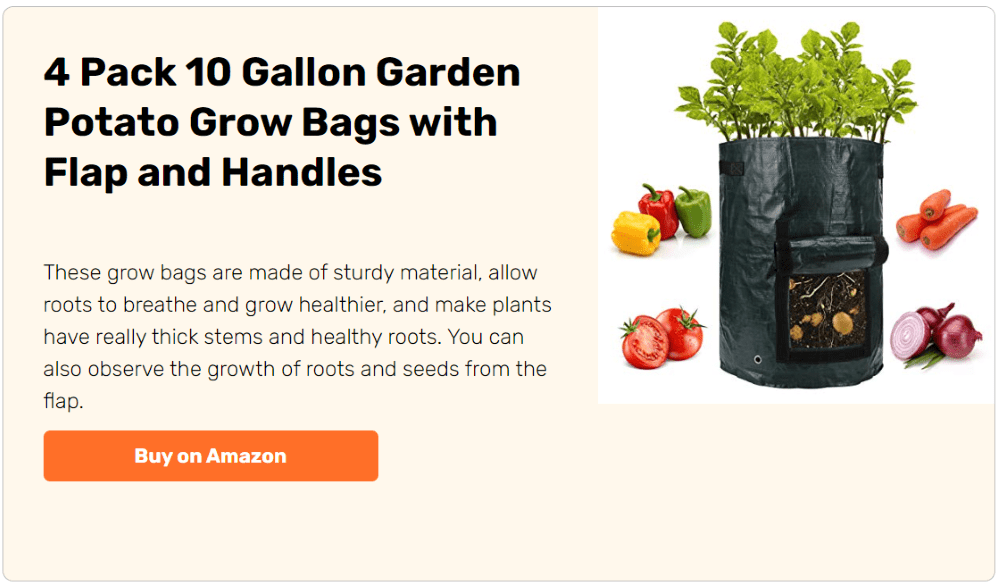
To sprout or “chit” seed potatoes, you simply arrange them ‘eyes’ upward in egg boxes or seed trays under sunlight in a cool but frost-free room. The chitting process will accelerate the growth of your potatoes.
The chitted seed potatoes will be ready for planting in your potato grow bags once the sprouts are 2cm tall. That usually takes four to six weeks.
“If you want to maximize the size of your potatoes, rub off all but three or four of the shoots at the top end of the tuber before planting out,” says the gardener and writer, Sarah Raven. “If you leave all the shoots intact, you’ll end up with lots of small potatoes.”

1. How to Create the Best Growing Conditions in a Potato Grow Bag
By growing your spuds in potato grow bags rather than a raised bed or in the garden, you can create perfect growing conditions for your plants. Potatoes grow best in well-drained, light, deep, loose compost, high in organic matter.
Potato plants also ‘perform best in acidic soil with a pH of 4.8 to 5.5. That said, some experts recommend ordinary peat-free compost for growing potatoes in a bag.
Remember, too, that choosing the right bag is just as important as selecting the right growing medium. We suggest that you use a large sturdy rubble bag or jute sack. You can also purchase potato grow bags.
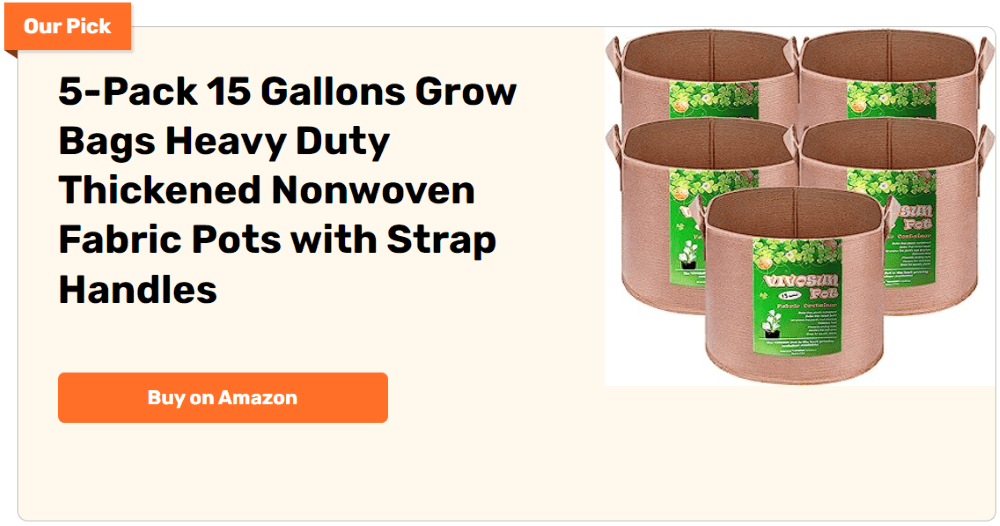
The most popular bag sizes are around 8 to 10 gallons. The bags should exclude light. Exposure to light can turn your potatoes green.
You can check against this kind of exposure by holding your potato grow bags against a light source. If any light comes through, simply line your bag with sheets of newspaper. Make sure you puncture small holes at the bottom of the bag to prevent it from becoming waterlogged.
“The important thing is that the bags need good drainage, so with re-used plastic bags do ensure that you make lots of extra holes in the bottom,” says Bob Flowerdew of Amateur Gardening Magazine.
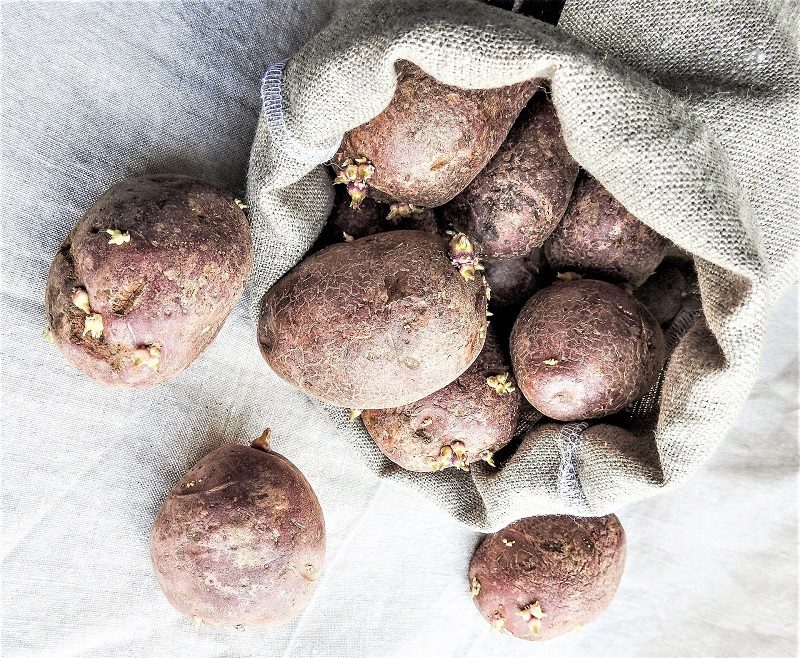
2. Planting Your Potato Seeds
Fill the bottom of the bag with around five inches of compost. Then roll the sides of the potato grow bag down to the level of the compost.
Plant three or four chitted potatoes – roots down – into the compost. Cover the seed potatoes with a few inches of additional compost. Unroll the first folds of the bag if needed.
Place your potato grow bag in a light, bright, frost-free space. One of the benefits of using potato grow bags is that you can move them when the weather turns bad or in search of sunlight. Your porch, balcony, or carport will suffice so long as the spot is sheltered but in good light. Water the seeds well.
“Potatoes require six to eight hours of full sun per day,” says celebrity urban gardener, Ron Finley. “Growing season varies by location, but spuds do best in temperatures above freezing and below 80°F.”
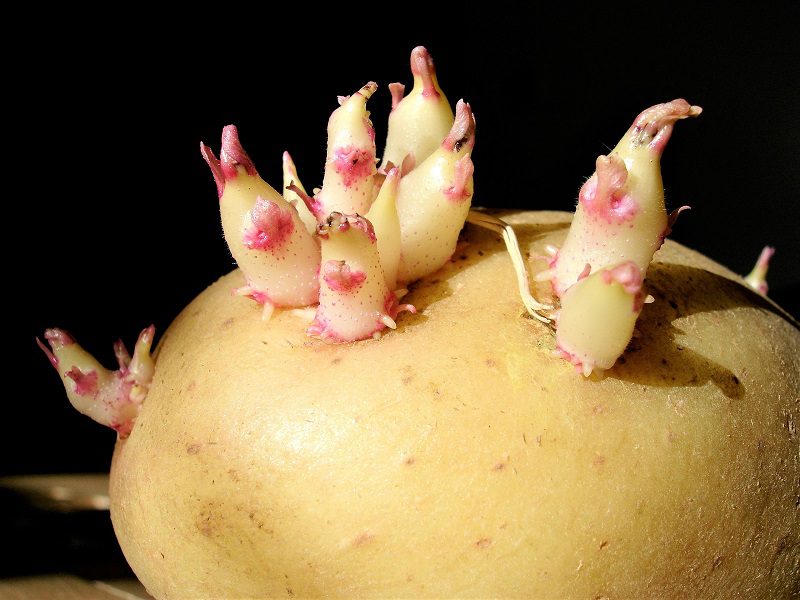
3. How to Care for Taters in a Potato Grow Bag
When the potato plant starts to grow green shoots, unfold the edges of the bag until it reaches the top of the shoots. Then cover the new shoots with another layer of compost.
Continue to do this every time shoots are visible or until the bag is full. When there is no more bag to unroll, then let the shoots grow.
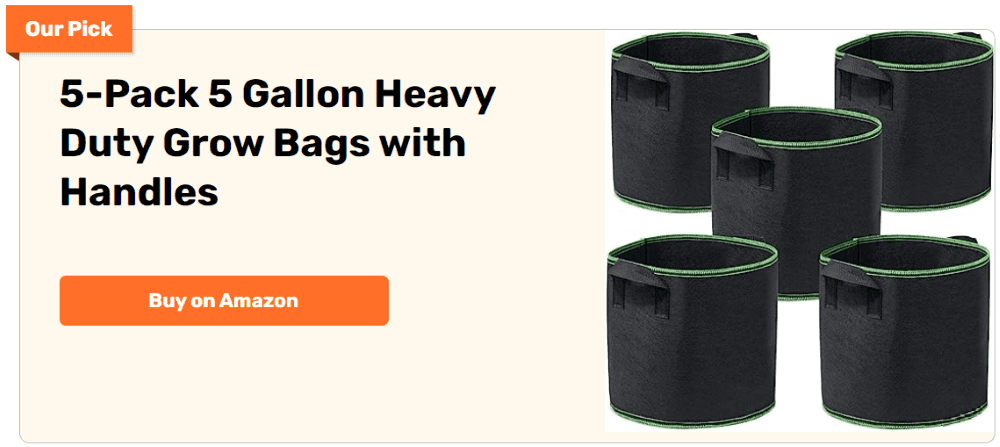
Water your potatoes whenever the top few inches of the soil dry out. “If the tubers dry out while they are developing, they won’t develop into potatoes, resulting in a smaller harvest,” says Deborah Miuccio, product research, and testing coordinator at Gardener’s Supply Company.
You should also watch out for potato beetles. These tiny pests lay eggs on the bottoms of leaves. If you catch them early in an infestation, you can pick them off by hand.
Traditionally, potato crops benefit from companion planting with horseradish, parsley, and flax to deter potato beetles. If you can, try keeping a few parsley plants near your potato grow bags to serve the same purpose.

4. Harvesting and Storing Your Potatoes
The above-ground portion of the potato plants will grow for several months. They will eventually produce purple or white flowers.
You can harvest your potatoes once the flowers, leaves, and stems of the plants have started to die back. Simply tip your potato grow bags and empty the contents on a sheet of tarp.
The compost can then go into your compost heap. – just make sure there are no potatoes left in the mixture.
Once you’ve cleaned your new potatoes, it’s time to store them. Small potatoes won’t keep longer than a few weeks. But larger potatoes can be stored in cool, dark environments for a few months.
What do you think? Have you ever used potato grow bags to grow a crop of taters? If we’ve neglected to mention other useful tips, please feel free to write about them in the comment section below. We’d love to hear from you.
Advantages of Potato Grow Bags Over Traditional Methods
Potato grow bags have become a popular choice among gardeners for cultivating potatoes. These innovative containers offer several advantages over traditional ground planting methods. Let’s explore these benefits in more detail.
Easy to Manage
Potato grow bags are incredibly user-friendly and versatile. Their ease of management is a standout advantage. You can place them in diverse locations like balconies, patios, decks, or small urban gardens. This adaptability is a game-changer for those with limited space.
Unlike traditional garden beds, these bags don’t require extensive preparation or tilling. They are ideal for renters or those needing to move their garden. The lightweight nature of the bags means they can be easily relocated to optimize sunlight exposure or to protect the plants from harsh weather conditions. This flexibility in placement and mobility makes potato grow bags a practical choice for gardeners of all levels.
Better Disease Control
Potato grow bags significantly reduce the risks associated with soil-borne diseases, a common challenge in traditional potato farming. In an open garden, potatoes are more vulnerable to diseases like blight or scab, which can thrive in soil and affect future crops. Potato grow bags circumvent this issue as they can be filled with sterile, disease-free compost and soil. This control over the growing medium is a crucial factor in preventing the spread of diseases.
Additionally, since these bags are used for a single growing season and then emptied, the chances of disease build-up are much lower than traditional methods. This aspect of potato grow bags protects the current crop and ensures a healthier start for the next planting cycle.
Enhanced Soil Conditions
Potato grow bags provide an excellent opportunity for gardeners to enhance soil conditions. This control over the soil environment is a significant advantage. In traditional ground planting, gardeners are at the mercy of their native soil, which may not always be ideal for potato growth.
However, with potato grow bags, you can create a customized soil mix tailored to the specific needs of potato plants. This mix can include the perfect balance of nutrients, proper pH levels, and organic matter, ensuring a rich growing medium.
The ability to adjust and enrich the soil directly affects the health and yield of the potato crop. Additionally, the soil in these bags warms up faster than ground soil, promoting earlier and more vigorous growth. This level of control over soil conditions is a key factor in the success of growing potatoes in grow bags.
Easy Harvesting
One of the most significant advantages of using potato grow bags is the ease of harvesting. Traditional methods of growing potatoes in the ground involve labor-intensive digging, which can be time-consuming and physically demanding. It also risks accidentally cutting or bruising the potatoes with garden tools. In contrast, harvesting potatoes from grow bags is simple and gentle.
When the potatoes are ready, tip over the bag and sift through the soil to collect your crop. This method eliminates the need for digging and reduces the time and effort involved in harvesting.
It’s particularly beneficial for those with limited physical ability or who wish to avoid the strain associated with traditional harvesting methods. Furthermore, it ensures that the potatoes are harvested gently, reducing damage and resulting in a cleaner and more pristine crop.
Reusable and Portable
Potato grow bags are not just a one-season wonder; they are reusable, making them a cost-effective and environmentally friendly option. After the growing season, you can simply empty the soil, clean the bags, and store them for the next year. This reusability starkly contrasts traditional methods, where the preparation of soil beds is a yearly task.
Additionally, the portability of these bags is a significant advantage. You can easily move them around to maximize sunlight exposure throughout the day or season. This mobility is especially useful in regions with variable weather conditions, allowing you to move your potato grow bags to sheltered locations during extreme weather. This level of control over the growing conditions is not possible in traditional ground planting, making grow bags an excellent choice for maximizing crop yield and health.
Improved Drainage
Proper drainage is a critical component of healthy potato growth; potato grow bags excel in this area. These bags are designed to prevent waterlogging, a common issue in traditional potato planting. Waterlogged soil can lead to root rot and other harmful conditions for potatoes.
The materials used in grow bags, such as fabric or woven plastic, naturally allow excess water to drain away, maintaining the ideal moisture balance in the soil. This feature is particularly beneficial during periods of heavy rainfall, where traditional garden beds might retain too much water.
Additionally, many grow bags come with pre-made drainage holes or the option to add more, giving gardeners further control over soil moisture levels. The improved drainage in potato grow bags promotes healthier root development and reduces the risk of fungal diseases, contributing to a more successful and abundant potato harvest.
Potato grow bags offer a convenient, efficient, and healthier alternative to traditional potato planting methods. They provide gardeners with the flexibility, disease control, and ease of use necessary for successful potato cultivation.
Frequently Asked Questions about Potato Grow Bags
What are potato grow bags?
Potato grow bags are specialized containers designed for growing potatoes. They are typically made from breathable materials like fabric, polyethylene, or burlap and offer a portable and space-efficient way to grow potatoes.
Why should I use potato grow bags instead of traditional planting?
Potato grow bags offer several advantages, including ease of management, better disease control, enhanced soil conditions, simple harvesting, reusability, portability, and improved drainage. They are especially useful for those with limited space.
Can I reuse potato grow bags?
Yes, potato grow bags are reusable. After the growing season, empty, clean, and store them for the next planting season.
What type of soil should I use in a potato grow bag?
Use a well-draining, nutrient-rich soil mix. You can customize the soil to create optimal growing conditions, which is harder to achieve in traditional ground planting.
How do I water potatoes in grow bags?
Water the potatoes when the top few inches of soil feel dry. Potato grow bags typically have good drainage, so ensure consistent moisture without overwatering.
Do I need to put holes in potato grow bags for drainage?
Many potato grow bags come with pre-made drainage holes. If not, or if additional drainage is needed, you can add more holes.
How many potatoes can I grow in a single bag?
It depends on the size of the bag. Typically, 3-4 seed potatoes per bag are recommended for medium-sized bags (around 10 gallons).
When is the best time to plant potatoes in grow bags?
Plant potatoes in grow bags after the danger of frost has passed, usually between March and April in most climates.
How do I harvest potatoes from a grow bag?
Tip the bag over to harvest and sift through the soil to collect the potatoes. This method eliminates the need for digging.
Can I grow other vegetables in potato grow bags?
Potato grow bags are versatile and can be used to grow other vegetables, especially those that benefit from well-drained soil, and are suitable for container gardening.
Conclusion
Potato grow bags are a revolutionary and practical solution for growing potatoes, especially for gardeners with limited space. They offer numerous benefits, such as ease of management, optimal disease control, enhanced soil conditions, and straightforward harvesting. These bags are not only reusable and portable, making them a sustainable choice, but also ensure improved drainage, which is crucial for healthy potato growth.

